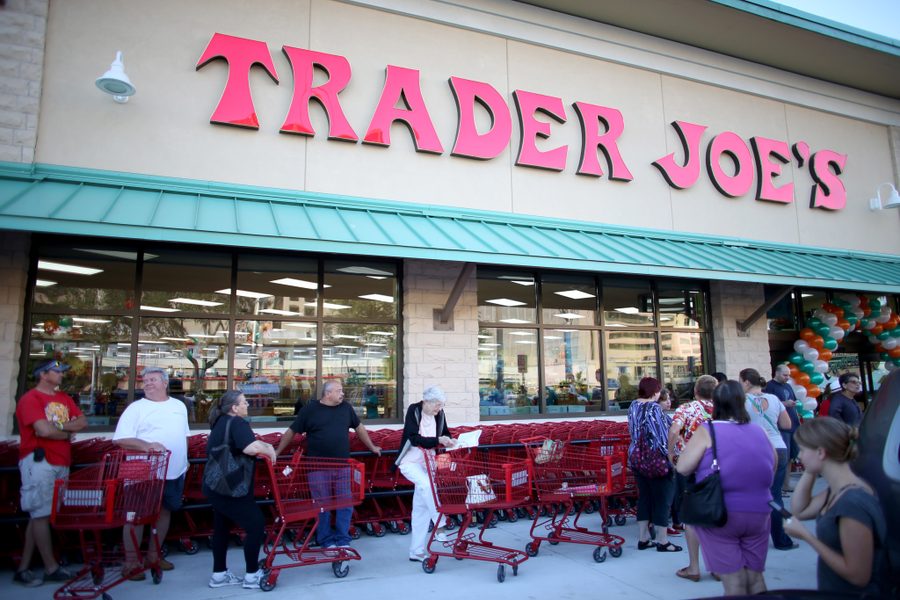Starbucks. Amazon. Now, Trader Joe’s Is Unionizing.
Workers are pushing for the grocery store chain’s first union.
Jeremy Gantz

Update: On June 7, 2022, workers at the Trader Joe’s store in western Massachusetts officially filed for a union election — a first at the grocery chain.
HADLEY, Mass. — As frontline worker fear and frustration grew in March 2020, Trader Joe’s CEO Dan Bane sent an anti-unionization letter to the grocery chain’s employees. In it, he pledged that if 30% of workers in any location wanted a union election, it would happen. No store ended up pushing for an election in that early pandemic period, but this May, a group of Trader Joe’s workers in western Massachusetts sent Bane their own letter. It announced their intention to unionize, while pointing out how federal labor law works.
“Of course, we know that if 30% of the crew at any store wish to have an election, it will happen, because that’s simply the law,” the Trader Joe’s United Organizing Committee wrote. Partly inspired by the campaigns to unionize Starbucks and Amazon, the group hopes to establish the chain’s first union — a new, independent union called Trader Joe’s United—at Store 512 in Hadley.
Discontent had been growing among staff for years regarding rolled-back benefits, stagnant wages and unaddressed health and safety issues. Then, during the pandemic, the company was not as vigilant as workers would have liked in maintaining Covid-19 precautions.
“A union is the only way we’ll have the power to protect what we have and improve our workplace,” says Maeg Yosef, who has worked at the store for 18 years. Despite the store’s workers clearly voicing displeasure, Yosef says, “things have continued to go in a direction that’s not good for the crew. The company continues to take things away.”
One big point of frustration is retirement fund contributions. When Yosef first began working at the Hadley store, Trader Joe’s contributed 15% of an employee’s annual pay to a 401(k). She said that dropped to 10% years ago. Then, “very quietly last summer [2021]” without any announcement, Yosef says, the company updated the employee handbook to remove guaranteed contributions. In January, some store employees were surprised and disappointed to receive only a 5% retirement contribution on 2021 earnings.
“If you’re making grocery store wages, it’s hard to save and plan for retirement,” Yosef says. “Most people aren’t receiving even close to a living wage for this area.” Massachusetts minimum wage is currently $14.25. MIT’s Living Wage Calculator puts Hadley’s living wage for a family of four at $27.52. And Trader Joe’s ended its $2-an-hour pandemic hazard pay bump in May 2021.
Yosef and other organizers asked the company to voluntarily recognize the union within 72 hours of their campaign announcement, noting a majority of the store’s nearly 100 workers supported unionization. That didn’t happen, so workers will soon be filing paperwork with the federal government to hold an election. The Hadley store’s manager has pledged the company will not interfere. The company did not respond to requests for comment.
With its small store footprints, artsy handmade signs and checkout line brass bells, Trader Joe’s has long cultivated a homey atmosphere. (Staff use the bells to communicate in lieu of a PA system.) All of that, along with cheap prices and an array of offbeat in-house brands, has helped “TJ’s” develop a cult following of, typically, younger and college-educated shoppers.
While the company has successfully carved out a niche customer experience, its niche isn’t small. The private company has more stores than Whole Foods (at 556) across the country, employs about 10,000 people and pulls in nearly $14 billion in annual revenue. The same German family that owns the discount chain Aldi owns Trader Joe’s.
Yosef, 41, says she enjoys her job, which involves everything from unloading trucks and stocking shelves to customer service and working the checkout. But she and many of her colleagues can no longer ignore the company’s shift away from worker-friendly policies, she says. “It’s become less helpful to crew members who want to have a career at the store — it’s become okay with high turnover,” Yosef says. “It’s become obvious that this direction is not good for workers and clear that we had to do something about it.”
Early in the pandemic, Trader Joe’s workers in other parts of the country began pushing for a union, circulating petitions and speaking with the Retail, Wholesale and Department Store Union. That effort went nowhere after major pushback from management, including anti-union lectures from store managers and a letter from Dan Bane, sent to employees’ homes, claiming unions were trying to “drive discontent.”
Instead, the Hadley store campaign, which began in January, has grown locally. “[N]o union organizers came to us,” the workers told Bane in their letter. And with the pandemic, slashed benefits and historic inflation, the time for unionization has come, Yosef says. “We just want to be able to take care of ourselves in the ways that the company is failing to take care of us. That, in turn, will enable us to do our jobs better.”
The group is determined to change the company’s course. “We’re a tight-knit crew and we know our jobs best,” Yosef says. “We feel the independent [union] route will give us the most autonomy.”
Jeremy Gantz is an In These Times contributing editor working at Time magazine.









